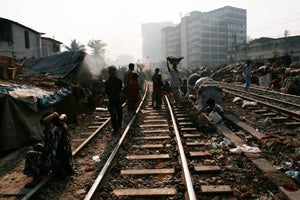 During the
South Asia Region workshop on "Promoting Access to Land and Housing", one underlying thread that ran through the discussions was on effective urban planning. Often, we encounter doubts on the usefulness of urban planning. While urban planning manifests in various forms, perhaps the most questionable one is comprehensive long term planning. While most people including the workshop participants acknowledge this framework (as in the South Korea or Singapore cases) it is widely debated as to whether this model works in the developing world such as in the South Asia region countries of Bangladesh, India, Pakistan, Nepal, etc. that face immediate urgencies, and more often than not, system failures in its urban development.
During the
South Asia Region workshop on "Promoting Access to Land and Housing", one underlying thread that ran through the discussions was on effective urban planning. Often, we encounter doubts on the usefulness of urban planning. While urban planning manifests in various forms, perhaps the most questionable one is comprehensive long term planning. While most people including the workshop participants acknowledge this framework (as in the South Korea or Singapore cases) it is widely debated as to whether this model works in the developing world such as in the South Asia region countries of Bangladesh, India, Pakistan, Nepal, etc. that face immediate urgencies, and more often than not, system failures in its urban development.
I agree very much with Dr Songsu Choi 's comments made during the workshop - that some planning is better than no planning. There are perhaps two common misconceptions about urban planning: (i) it is a costly exercise that takes a very long time to complete; and (ii) a plan is a rigid, inflexible regulatory document that does not respond to on-the-ground needs and changes. Yes, while the typical developed country model of comprehensive urban planning may require high technology, high capacity analysis, extensive modeling and typically large amount of resources, that is not the only form of planning. Gathering a block of residents and agree that a road is needed at a certain alignment is planning; the roads agency meeting the drainage agency to coordinate construction schedule for a road is planning; the community leader discussing with the residents on the vision of the community is planning.
We must recognize the intrinsic values of planning and then determine the corresponding resources to commit to it.
Urban planning embodies a vision that conveys the aspirations of both the government and the people. The better aligned the collective vision from both the government and the people, the more realistic and implementable are the plans. It does not have to paint a lofty, unattainable goal but it should be attractive and contextual- making use of the unique assets and characteristics of each place, community or city. In fact, the more down to earth the vision is, and the more the people can relate to it, the better.
Urban planning is a value creation tool which often generates more than enough return just from its own merits (although one may need to have some patience!). It is a powerful tool to generate economic opportunities and facilitate economic development. For example, a well-planned and functioning city is an efficient city that can reduce congestion costs and negative externalities. If we can take it one step further beyond just function and efficiency, but towards livability and attractiveness, that will generate even greater economic benefits. In addition, a little packaging built on the planning vision can be a powerful marketing material to attract investors. (Of course, realizing the vision would need much more than a plan: strong political will, legal backing, social consensus amongst others; however, a transparent and well executed plan will instill confidence in investors and is one of the first step towards generating a virtuous upward growth cycle.)
Urban planning is a coordination and communication instrument, the common document that brings together stakeholders. Just taking the example at the government level, arguments, trade-offs and compromises are better done at the table - the draft urban plan can be used as a starting point for discussions amongst agencies with different mandates and interests. Perhaps even more importantly, the final document reflects agreements and decisions from these discussions that should be upheld. it would, therefore, minimize potential conflicts amongst different agencies during implementation. This applies to all aspects of urban development - from road, water, drainage, sewers, electricity and community services, health and education facilities to economic development direction and goals. Underlying this is the need for one main coordination agency and a clear division of work between the agencies as well as the various levels of government.
Therefore, urban planning is not just about restricting the land use, gross floor area, height limits and imposing various control guidelines for plots of land.
Perhaps then, the question is how can urban planning be carried out in a useful manner appropriate to the developing countries' or cities' contexts? If tackling the issue at the city level is too complicated, perhaps start with one neighborhood or one community. If five agencies cannot agree, perhaps align the interests of three first. If there is not enough budget to implement the entire wish list, prioritize tasks and do the most urgent and critical one first. As the old cliché goes, when there's a will (especially political will), there's a way. If we completely abandon the will to plan, there may never even be a starting point for change.
Be ambitious but pragmatic; dream big but start small; think long term but act now.


Join the Conversation